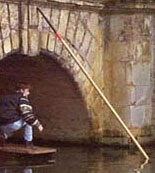Punting guide to the River Cam
 A very old guide to punting from Cambridge to Grantchester - picking out some of the highlights. Not especially useful but it seemed a shame to lose it.
A very old guide to punting from Cambridge to Grantchester - picking out some of the highlights. Not especially useful but it seemed a shame to lose it. 
The rollers
A set of wheels where you can push the punt up the 1 metre height difference to the upper river, by-passing the weir. Punts are heavy, and some of the wheels are missing! On the way back, if you all sit in the punt as it rolls down, it will sink (and there's usually a big audience with cameras). The adjacent weir is where good swimmers can try white water punting.

Fen Causeway After the last road bridge, the river bed is actually paved, as this section was used as a swimming pool of sorts in the 1900s. There's still a paddling pool in summer. A colony of not-too-friendly geese is often in residence here.
Two low bridges Popular site for bridge-jumping (ie climbing up off the punt onto the bridge, over the bridge, and back onto the punt at the other side before it's gone). Warning: Only small and light people should even think of trying this, or we'll fine you £lots to repair the punt...
Hobson's Paradise Also formerly a swimming area, now somewhat overgrown. Several grassy clearings make this a popular place for barbecues in the summer.
The forest This is as close as Cambridge gets to a forest (and it's not very close). Some trees have ropes to swing on; there are a number of student residences (abnd what was an abandoned hospital) lurking among the trees.
The deep bend You may find the river is significantly deeper than the punt pole here. It's not clear why as there's very rarely enough flow of water to deepend the river. To make it more interesting, the bank is covered with nettles too...
The nudist colony You'll see a hedge next to the river with a sign saying Private Property. Apparently there's a nudist club behind it...
Grantchester meadows A large area of open countryside, sometimes quite crowded in the summer. If you look back, there's a good view of Cambridge. All you can see is the University Library tower and (of course) Johns' chapel.
Grantchester Small village including four pubs (The Red Lion, The Blue Ball, The Green Man and The Rupert Brooke), a few houses, and a church. Of the pubs, the Red Lion is the nearest to the river and has a large garden, often full of suspiciously wet-looking students. Rupert Brooke, who lived here as a student, wrote 'The old vicarage, Grantchester', one of his most famous poems.
The Orchard A long Cambridge tradition (since 1897, apparently) sees students punt here for tea on deckchairs set among the apple trees. A traditional destination after May Balls. Now expanded to include an indoor restaurant.
Byron's Pool Named when Lord Byron (famous poet) used to swim here as a student. The weir here is as far as you can go with St John's punts - the river continues upstream for about sixteen miles to the east. If you get this far, you definitely know how to punt...
ODDS & ENDS Quant n.
This is the little-known official name for a punt pole. The first record of this word was in 1440, when it was common to see barges in Norfolk pushed with similar poles. It later led to 'quanting' being known as an alternative name for punting. Each college (and a few of the commercial punt hire companies) has its own colour, in order to identify lost poles - some of the more common ones are illustrated above on the right. Scudamores is probably the biggest of the punt hire companies, and you'll see a lot of their poles around. There are also (rare) aluminium poles, and even carbon fibre ones - they're better but they need to be treated with respect to avoid damage, so don't tend to get hired out as much.
Quant n.
This is the little-known official name for a punt pole. The first record of this word was in 1440, when it was common to see barges in Norfolk pushed with similar poles. It later led to 'quanting' being known as an alternative name for punting. Each college (and a few of the commercial punt hire companies) has its own colour, in order to identify lost poles - some of the more common ones are illustrated above on the right. Scudamores is probably the biggest of the punt hire companies, and you'll see a lot of their poles around. There are also (rare) aluminium poles, and even carbon fibre ones - they're better but they need to be treated with respect to avoid damage, so don't tend to get hired out as much.


Punting in Oxford
Punts were originally developed for shooting wild fowl, and the punter would stand somewhere in the low bit of the punt with a big gun on the platform (which was the front of the punt). When punting became popular in Oxford & Cambridge, Oxford stubbornly kept punting in the traditional way, without using the platform, whereas people in Cambridge soon realised that it was far easier to steer by standing on the platform, using the punt in the opposite direction. Even now, if you go to Oxford, you'll see some die-hards punting at the wrong end of the punt.

Pedalo punts A few of these were recently introduced at Oxford, on the grounds that it was easier for the tourists. Vetoed in Cambridge on the grounds that it was too tacky.


